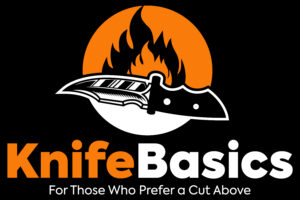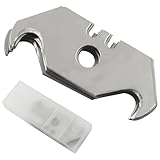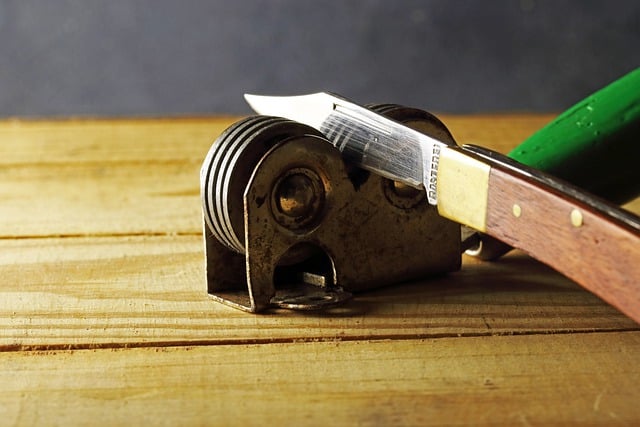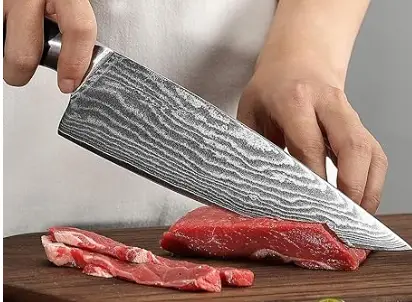AUS 10 steel also known as AUS-10A steel is produced by the Aichi Steel Company based in Tokai city in Japan. It wasn’t known by many people in the past but it started gaining popularity with it being used in most imported Japanese knives.
AUS 10 steel is one of the best mid-level steels used to make good-quality knives. It has good edge retention, toughness, hardness, corrosion resistance, and wear resistance in addition to its affordability.
AUS 10 steel is the best type of steel under the AUS series (AUS-6, AUS-8, and AUS-10), thanks to its high carbon and vanadium content. Additionally, AUS-10 is stainless steel as it contains high amounts of Chromium in its alloy.
The following are some of the qualities that make the AUS-10A steel stand tall among its counterparts:
AUS 10 Steel Composition
| Element | Content (%) |
|---|---|
| Carbon C | 1.10% |
| Chromium Cr | 14.50% |
| Nickel Ni | 0.49% |
| Vanadium | 0.25% |
| Silicon Si | 1.00% |
| Molybdenum Mo | 0.30% |
| Manganese Mn | 0.50% |
| Phosphorus P | 0.04% |
| Sulfur S | 0.03% |
- Carbon C 1.10%: Increases edge retention, hardness, and tensile strength. It also improves steel resistance to wear, abrasion, and corrosion.
- Chromium Cr 14.50%: Formation of Chromium carbides. Increases the blade’s hardness, tensile strength, and corrosion resistance.
- Molybdenum Mo 0.31%: It improves machinability and hardness.
- Vanadium V 0.25%: inhibits grain growth during elevated temperature processing and heat treatment, which enhances the strength and toughness of steel. It also forms carbides that increase wear resistance.
- Nickel Ni 0.49%: improves strength and toughness. It increases hardenability but not as much as some of the other alloying elements in steel. It can enhance corrosion resistance in significant amounts
- Phosphorous P 0.04%: Increases the strength and improves machinability of steel
- Manganese Mn 0.50%: improves the strength and hardness of steel. When the steel is heat-treated, hardenability is improved with increased manganese.
- Silicon Si 1.00%: Increases strength and heat resistance.
- Sulfur S 0.03%: Improves machinability but is regarded as an impurity in high quantities.
- SK5 Steel Durability: Made from industrial-grade SK5 high carbon steel, these heavy duty utility blades provide exceptional hardness and edge retention. Compared to standard carbon steel, SK5 offers improved wear resistance and extended life span, ensuring fewer blade changes and higher efficiency during cutting tasks. Whether you're working on renovation projects, packaging, or construction sites, these blades can handle tough materials like carpet, drywall, rubber, and rope with ease
- Standard Size Fit: This utility knife blades 100 pack is crafted to meet universal blade specifications, ensuring a perfect fit with most retractable utility knives, folding knives, and box cutters. Whether you're replacing utility knife blades for everyday tasks or switching out box cutter blades on the job, these standard-size blades deliver reliable compatibility and performance you can count on across various tools and scenarios
- Razor Sharp Edge: Our razor blades for utility knife are precision-honed to deliver ultra-sharp, clean cuts every time. Engineered with a refined edge angle, these blades slice effortlessly through thick cardboard, leather, carpet, vinyl, linoleum, soft metals, and more. The sharpness reduces drag, improves control, and minimizes hand fatigue—making it the ideal choice for DIYers, contractors, or warehouse professionals
- Safe Storage Box: Each set comes with a compact and durable utility blade storage box that protects blades from dust, moisture, and accidental contact. The slide-out design allows safe, one-at-a-time access to blades while keeping unused blades neatly organized. Whether stored in a toolbox, desk drawer, or tool belt, this box keeps your workspace safer and your workflow smoother
- Trusted by Pros & DIYers: These replacement blades for utility knife are built with Jetmore’s commitment to precision and durability. Whether you're a professional in construction, a warehouse operator, a DIY hobbyist, or simply handling everyday home repairs, Jetmore delivers blades you can trust. We stand behind our quality—so you can cut with confidence, knowing your tools won’t let you down
- Notice: Be sure to watch our HOW-TO video before using it. It can help you slide the utility blade out quickly and easily
- Super Versatility: It is made entirely according to standard utility knife blades and fits most standard & fixed utility knives perfectly
- Affordable: Includes 100-pack replacement blades and they come in a well-built case for safe storage and disposal. Each blade is rigorously tested and we firmly believe this is a great deal
- Durability: WORKPRO utility knife blades are made from SK5 steel, which is of high quality and durability
- Sharp: The knife blades are highly sharp and cut through lots of materials easily and without hesitation. Ideal for cutting cardboard, leather, linoleum, rope, soft metal, etc
- Ample Supply: Enjoy a generous pack of 50 utility hook blades, ensuring you have enough for your cutting tasks without the hassle of frequent replacements.
- Effortless Cutting: Engineered for precision, these sharp blades effortlessly cut through materials like carpet, wallpaper, hard plastic, and leather, making many projects a breeze.
- Superior Durability: Crafted from high-quality carbon steel, our blades provide exceptional sharpness and longevity, resisting deformation for reliable performance.
- Enhanced Safety Features: The unique hook-shaped design keeps the sharp edge recessed, minimizing injury risk and allowing safer usage, even during accidental drops.
- Convenient Storage: Each pack comes with a protective plastic storage box, keeping your blades secure and organized, while reducing the risk of accidents when not in use.
AUS-10 Hardness
The high carbon content makes the AUS 10 steel hard, it spots 58- 60 HRC on the Rockwell scale of hardness. The sharpness however makes the knives relatively fragile, that’s why the precise amount of manganese, silicon, and nickel have been added to the AUS-10 alloy to increase the elasticity and ductility of the material.
AUS-10 Edge Retention
AUS 10 steel alloy is well refined and has a high amount of carbon. The Carbon and Vanadium elements aid in the formation of strong fine carbides that contribute to great edge retention.
Steel with more quantity of fine carbides usually gets a lot sharper compared to ones with smaller amounts of large carbides.
Sharpening AUS-10
It is very easy to sharpen the knives made of AUS-10 stainless steel and they attain a very perfect edge. The sharpening of AUS-10A steel is easy and can be achieved through different sharpening materials.
However, you may have to be careful during this process, such as avoiding the use of a pull-through sharpener.
AUS-10 Corrosion Resistance
The AUS-10 stainless steel alloy contains a unique combination of Chromium, Nickel, and Vanadium Elements. Its unique combination of the elements makes the AUS-10 stainless steel resistant to rust and other corrosive substances.
It is good but not the best out there, other steels like LC200N steel and H1 steel offer better corrosion resistance.
AUS-10 Wear Resistance
Thanks to the unique combination of the steel alloy. Vanadium, Chromium, and Molybdenum give AUS-10 steel high levels of wear resistance.
AUS 10 steel contains more carbon and vanadium elements than any AUS series steel, this makes it the hardest blade type in the AUS category.
AUS-10 Toughness
AUS-10A offers good toughness as its hardness is in the range of 58HRC, the addition of Nickel also greatly improves its toughness.
The toughness of the AUS 10 steel also ensures that the knives will not easily break or chip under pressure during sharpening and repeated cutting.
AUS-10 vs other steel
AUS-10 vs VG-10 Steel
VG-10 steel is a premium Japanese steel that offers better properties like hardness, edge retention, and corrosion resistance. The only advantage that AUS 10 steel has over VG-10 steel is that it is affordable and offers slightly better toughness.
The knives made of AUS 10 steel will require frequent sharpening due to less edge retention ability while the ones made of VG-10 can maintain an ideal edge for a longer period of time.
Both AUS 10 steel and VG-10 steel are stainless steels with high Chromium content. However, VG-10 steel offers much better rust resistance.
AUS-10 vs AUS-8 Steel
AUS 10 steel has more wear resistance ability than AUS-8 steel this is due to its increased carbon content. AUS-8 is a bit tougher due to the presence of more Nickel elements in its alloy.
Both AUS-10 and AUS-8 have good wear resistance due to their alloys and are almost identical.
AUS-10 vs AUS-6
AUS-6 is softer and can break more easily while in use than AUS-10. It is easier to re-sharpen AUS-6 than AUS-10 as it has a low hardness rating.
AUS-10 is better than AUS 6 in all the properties. AUS 6 steel is the low end of the AUS series and one of the most disliked steel out there.
Is AUS-10 Steel Good?
Yes! AUS-10 stainless steel is generally strong and relatively tough with a great ability to handle rust and offer good edge retention. It is also easy to sharpen and rated by many people as top-quality steel.
It is more similar to AISI 440C and considered as its Japanese equivalent only that it offers slightly better performance due to the addition of Vanadium. AUS-10 steel differs from the well-known 154CM steel due to the possession of smaller grained carbides.
The knives made of AUS 10 steel are very durable and rust-resistant. AUS-10 steel also performs better than other carbon steels in matters of rust and corrosion resistance.






